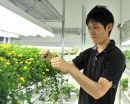(Press-News.org) Membrane proteins and large protein complexes are notoriously difficult to study with X-ray crystallography, not least because they are often very difficult, if not impossible, to crystallize, but also because their very nature means they are highly flexible. The result is that when a structure can be obtained it is often of low resolution, ambiguous and reveals a mosaic-like spread of protein domains that sometimes create more puzzles than they solve. [Schröder, Levitt & Brunger. (2014), Acta Cryst. D70, 2241-2255; doi: 10.1107/S1399004714016496 ]
Now, Gunnar Schröder of the Institute of Complex Systems at the Forschungszentrum Jülich and the University of Düsseldorf, Germany and colleagues at Stanford University School of Medicine, USA have reviewed their earlier refinement technique known as Deformable Elastic Network (DEN) and found ways to optimize it successfully for the investigation of several particularly problematic protein structures including soluble proteins and membrane proteins up to a resolution limit ranging from 3 to 7Å.
The team explains that advances in X-ray technology and light sources have in recent years led to structures for previously intractable proteins such as the ribosome, transcription complexes and even viruses. The details then lie in a successful refinement that can provide valuable information about the structure in question despite lower resolution than would normally be desirable. "The interpretation of low-resolution diffraction data is generally difficult," the team says, "owing to the unfavorable ratio of parameters (variable degrees of freedom, such as flexible torsion angles or Cartesian atomic coordinates) to observables (observed diffraction intensities)." Ambiguities and errors of interpretation abound.
The DEN approach begins with a model, a prediction, of the target structure containing as much information as is known ahead of the insertion of the diffraction data, and determines which features of the model ought to be adjusted to fit the diffraction data emerging from the X-ray experiments. In other words, a null hypothesis is applied; those parts of the model not predicted to alter the diffraction data are retained as is. Distances between randomly chosen pairs of atoms within the structure are tested and tweaked accordingly within a distance restraint, customarily referred to as the elastic network potential. This approach guides the structure towards the lowest energy landscape; it nudges it along towards an optimal structure wherever that may lie in the landscape, rather than forcing it in a particular direction.
The team has undertaken a proof of principle on their DEN approach with five representative protein cases with a particular focus on one example: the ß2 -adrenergic receptor, a membrane-bound protein consisting of seven transmembrane helices which belongs to the class of G-protein coupled receptors. The structure of the activated form of this protein was refined from a 3.5Å resolution data set in complex with an agonist and a nanobody that had been used to facilitate the crystallization process. They also had success with photosystem I, a membrane-protein complex involved in plant photosynthesis, which consists of 2334 amino acids in 12 polypeptide chains; an error-rich data set for AAA-ATPase p97, a hexameric protein complex in which each of the protomers contains an N-terminal domain and two nucleotide-binding domains; and the human myxovirus resistance protein (MxA), an enzyme that helps defend against viruses.
"We envision several extensions of DEN refinement that could potentially improve its performance and applicability," the team reports. They add that using more than one reference model from multiple known structures might allow the DEN restraints to be defined more precisely still with appropriate weight being given to each input model. "This would increase the overall amount of information used to guide the refinement," the team explains.
INFORMATION:
A refined approach to proteins at low resolution
2014-09-19
ELSE PRESS RELEASES FROM THIS DATE:
Reflected smartphone transmissions enable gesture control
2014-09-19
With almost all of the U.S. population armed with cellphones – and close to 80 percent carrying a smartphone – mobile phones have become second-nature for most people.
What's coming next, say University of Washington researchers, is the ability to interact with our devices not just with touchscreens, but through gestures in the space around the phone. Some smartphones are starting to incorporate 3-D gesture sensing based on cameras, for example, but cameras consume significant battery power and require a clear view of the user's hands.
UW engineers have developed a ...
Patients with advanced, incurable cancer denied palliative care
2014-09-19
Many patients with advanced, incurable cancer do not receive any palliative care, reveals new research to be presented later this month at the ESMO 2014 Congress in Madrid, Spain, 26-30 September. The findings are astonishing as they come at the same time as 15 new oncology centres in Europe, Canada, South America and Africa are being awarded the prestigious title of 'ESMO Designated Centre of Integrated Oncology and Palliative Care.'
SR I Dr Alexandru Grigorescu, medical oncology consultant at the Institute of Oncology Bucharest, Romania, member of the ESMO Palliative ...
Graphene sensor tracks down cancer biomarkers
2014-09-19
An ultrasensitive biosensor made from the wonder material graphene has been used to detect molecules that indicate an increased risk of developing cancer.
The biosensor has been shown to be more than five times more sensitive than bioassay tests currently in use, and was able to provide results in a matter of minutes, opening up the possibility of a rapid, point-of-care diagnostic tool for patients.
The biosensor has been presented today, 19 September, in IOP Publishing's journal 2D Materials.
To develop a viable bionsensor, the researchers, from the University of ...
Simple test can help detect Alzheimer's before dementia signs show: York U study
2014-09-19
TORONTO, Sept. 19, 2014 — York University researchers say a simple test that combines thinking and movement can help to detect heightened risk for developing Alzheimer's disease in a person, even before there are any telltale behavioural signs of dementia.
Faculty of Health Professor Lauren Sergio and PhD candidate Kara Hawkins who led the study asked the participants to complete four increasingly demanding visual-spatial and cognitive-motor tasks, on dual screen laptop computers. The test aimed at detecting the tendency for Alzheimer's in those who were having cognitive ...
Shrink-wrapping spacesuits
2014-09-19
For future astronauts, the process of suiting up may go something like this: Instead of climbing into a conventional, bulky, gas-pressurized suit, an astronaut may don a lightweight, stretchy garment, lined with tiny, musclelike coils. She would then plug in to a spacecraft's power supply, triggering the coils to contract and essentially shrink-wrap the garment around her body.
The skintight, pressurized suit would not only support the astronaut, but would give her much more freedom to move during planetary exploration. To take the suit off, she would only have to apply ...
New hadrosaur noses into spotlight
2014-09-19
Call it the Jimmy Durante of dinosaurs – a newly discovered hadrosaur with a truly distinctive nasal profile. The new dinosaur, named Rhinorex condrupus by paleontologists from North Carolina State University and Brigham Young University, lived in what is now Utah approximately 75 million years ago during the Late Cretaceous period.
Rhinorex, which translates roughly into "King Nose," was a plant-eater and a close relative of other Cretaceous hadrosaurs like Parasaurolophus and Edmontosaurus. Hadrosaurs are usually identified by bony crests that extended from the skull, ...
Researchers discover new gene responsible for traits involved in diabetes
2014-09-19
A collaborative research team led by Medical College of Wisconsin (MCW) scientists has identified a new gene associated with fasting glucose and insulin levels in rats, mice and in humans. The findings are published in the September issue of Genetics.
Leah Solberg Woods, Ph.D., associate professor of pediatrics at MCW and a researcher in the Children's Hospital of Wisconsin Research Institute, led the study and is the corresponding author of the paper.
The authors of the paper identified a gene called Tpcn2 in which a variant was associated with fasting glucose levels ...
Don't cry wolf: Drivers fed up with slowing down at inactive roadwork sites
2014-09-19
The results of the QUT Centre for Accident Research & Road Safety - Queensland (CARRS-Q) study have been presented at the Occupational Safety in Transport Conference (OSIT) which is being held on the Gold Coast and finishes today.
Dr Ross Blackman, a CARRS-Q road safety researcher, said speed limit credibility was being put at risk when reduced speed limits and related traffic controls remained in place at inactive roadwork sites.
"It's seen as crying wolf. If people are asked to slow down at roadwork sites but find there is no roadwork being undertaken they become ...
Long-distance communication from leaves to roots
2014-09-19
Leguminous plants are able to grow well in infertile land, and bear many beans that are important to humans. The reason for this is because most legumes have a symbiotic relationship with bacteria, called rhizobia, that can fix nitrogen in the air and then supply the host plant with ammonia as a nutrient.
The plants create symbiotic organs called nodules in their roots. However, if too many root nodules are made it will adversely affect the growth of the plants, because the energy cost of maintaining excessive nodules is too large. Therefore legumes must have a mechanism ...
Lymphatic fluid used for first time to detect bovine paratuberculosis
2014-09-19
Paratuberculosis, also known as Johne's disease, is caused by the bacterium Mycobacterium avium subspecies paratuberculosis (MAP). In Austria, there is a legal obligation to report the disease. Paratuberculosis mainly affects ruminants and causes treatment-resistant diarrhoea and wasting among affected animals. The disease can cause considerable economic losses for commercial farms. The animals produce less milk, exhibit fertility problems and are more susceptible to other conditions such as udder inflammation.
To date there has been no treatment for paratuberculosis. ...




